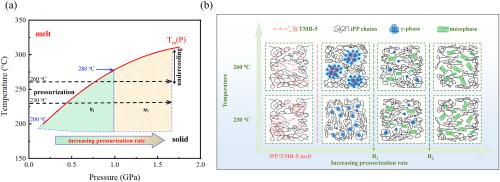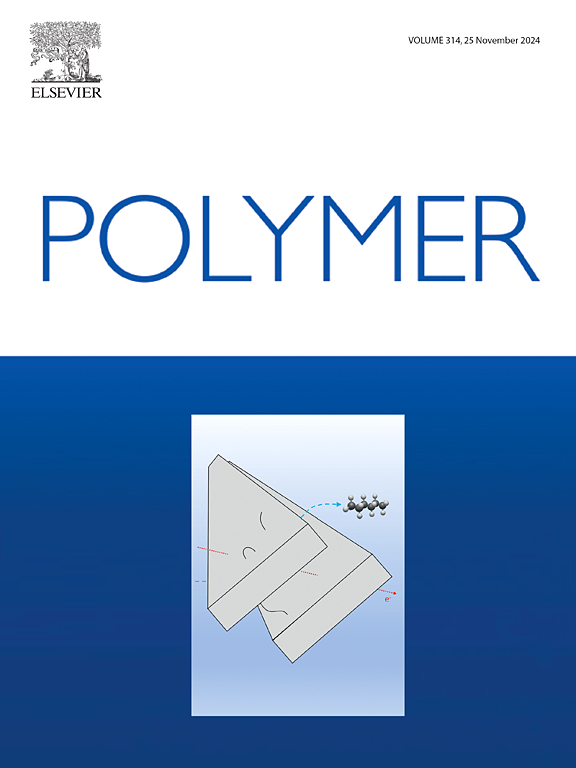Pressurization induced crystallization of iPP containing self-assembly β-nucleating agents: Role of pressurization rate and temperature
IF 4.1
2区 化学
Q2 POLYMER SCIENCE
引用次数: 0
Abstract
Pressurization-induced crystallization (PIC) of isotactic polypropylene (iPP) with the β-nucleating agent (β-NA) was investigated by wide-angle X-ray diffraction, polarizing microscopy and differential scanning calorimetry measurement. A competitive formation process between the mesophase and γ-iPP was found in the PIC process. Specifically, increasing the pressurization rate can significantly suppress the formation of γ-phase and induce the formation of mesophase with the range between the critical pressurization rate from R1 to R2, however, when the temperature exceeds a critical value of about 280 °C, only mesophase forms despite any pressurization rate. Moreover, instead of β-iPP, β-NA serves as an effective nucleating agent and promotes the formation of γ-iPP under PIC treatment, and its self-assembly morphology can also be controlled by verifying pressurization rates and/or temperatures. As a result, a reasonable mechanism was proposed to show how to tune the crystalline polymorphism and morphology of iPP materials by using the “pressurization” method, and a pressure-temperature crystallization structural diagram was established to analyze the synergistic effect of pressurization rate and temperature on the crystallization polymorphism of iPP. It demonstrates that pressurization is likely to be a universal method for tailoring polymer crystallization within an appropriate temperature range.


含自组装β-成核剂的iPP的加压诱导结晶:加压速率和温度的作用
采用广角x射线衍射、偏光显微镜和差示扫描量热法研究了β-成核剂(β-NA)对等规聚丙烯(iPP)的加压诱导结晶(PIC)作用。在PIC过程中发现了中间相与γ-iPP之间的竞争性形成过程。其中,增大加压速率可以显著抑制γ相的形成,并在临界加压速率R1 ~ R2范围内诱导中间相的形成,但当温度超过280℃左右的临界值时,无论加压速率如何,都只能形成中间相。此外,在PIC处理下,β-NA代替β-iPP作为有效的成核剂,促进γ-iPP的形成,并且其自组装形态也可以通过验证加压速率和/或温度来控制。结果,提出了利用“加压”方法调控iPP材料结晶多态性和形貌的合理机理,并建立了压力-温度结晶结构图,分析了加压速率和温度对iPP结晶多态性的协同效应。这表明,在适当的温度范围内,加压可能是一种通用的方法来定制聚合物结晶。
本文章由计算机程序翻译,如有差异,请以英文原文为准。
求助全文
约1分钟内获得全文
求助全文
来源期刊

Polymer
化学-高分子科学
CiteScore
7.90
自引率
8.70%
发文量
959
审稿时长
32 days
期刊介绍:
Polymer is an interdisciplinary journal dedicated to publishing innovative and significant advances in Polymer Physics, Chemistry and Technology. We welcome submissions on polymer hybrids, nanocomposites, characterisation and self-assembly. Polymer also publishes work on the technological application of polymers in energy and optoelectronics.
The main scope is covered but not limited to the following core areas:
Polymer Materials
Nanocomposites and hybrid nanomaterials
Polymer blends, films, fibres, networks and porous materials
Physical Characterization
Characterisation, modelling and simulation* of molecular and materials properties in bulk, solution, and thin films
Polymer Engineering
Advanced multiscale processing methods
Polymer Synthesis, Modification and Self-assembly
Including designer polymer architectures, mechanisms and kinetics, and supramolecular polymerization
Technological Applications
Polymers for energy generation and storage
Polymer membranes for separation technology
Polymers for opto- and microelectronics.
 求助内容:
求助内容: 应助结果提醒方式:
应助结果提醒方式:


